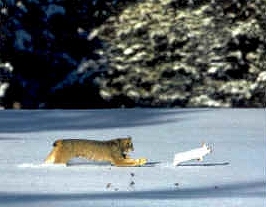
Canada Lynx
Lynx canadensis
Status
Native to both Newfoundland and Labrador.
Habitat
Prefers old growth boreal forests with dense undercover, but the lynx will live in other habitats where undercover and prey numbers are adequate. They are often found in regenerating forests after a fire – where the snowshoe hare population has increased. When prey is scarce in the forested areas, the lynx will venture on to the tundra for food.
Range
Found in the boreal forest across Canada from Newfoundland to the Yukon Territory. Lynx are usually found in areas that are occupied by snowshoe hare.
Food
During the winter, about 75% of the lynx’s diet is snowshoe hare. Lynx populations peak approximately every 10 years, shortly after a peak in the snowshoe hare’s population cycle. Also, the lynx population will decrease after a crash in the snowshoe hare population. When snowshoe hare numbers are low, the lynx’s diet is supplemented by various rodents and birds such as voles, squirrels, grouse and sparrows. Moose and caribou (usually calves) may account for some of the lynx’s diet, but they rarely attack large prey.
The lynx is nocturnal and hunts at night. It uses its sight and hearing mainly for hunting, focusing less on its sense of smell. To catch prey, the lynx will wait silently near a trail for movement. The lynx stalks and ambushes its prey.
Predators/Threats
Humans are the main predator of the lynx; others include wolves and coyotes. A lynx will usually escape wolves by climbing, but has little chance in the open.
Lifespan
Average lifespan varies between 10-20 years.
Appearance
The lynx has a short body and long legs and is often distinguished by its tufted ears and short black-tipped tail. The face is broad with prominent eyes and ruffs of fur on the cheeks. Fur is long, usually a pale gray or buff with brown streaks. During summer, the coat looks ragged, but is thick and silky during the winter months. Molting occurs annually during the Spring.
The lynx is well adapted for snowy habitats with its thick coat and large, snowshoe-like feet. The feet are also fur covered which helps in traveling over snow and ice.
Breeding Biology
A lynx can breed during its first year, even though full growth isn’t reached until its second year. Mating occurs between January and March. After a gestation period of about 60 days, an average litter of three kittens are born between March and May. Kittens are weaned after two months and leave the mother after 6-9 months.
Average Weight/Measurements
Average weight of female/male adults is (17 lbs)(7.7 kg) – may range between (11 – 35 lbs)(4.9 – 15.8 kg) – Average height is about (2 ft)(60 cm) at the shoulder. Length can range from (2 ft)(72 cm) to (3 ft)(1m).
Notes:
- One lynx may consume up to 200 hare in one year.
- Lynx were extremely rare in Newfoundland prior to the introduction of the snowshoe hare in the mid-nineteenth century. Since then, lynx numbers have ranged from abundant to scarce in response to the snowshoe hare population.
At Salmonier Nature Park
- Salmonier Nature Park has had successful lynx births in the past. These animals have been provided to reputable Canadian zoos.
- Wild lynx are present in the Park, and on occasion, have preyed upon our Canada geese and snowshoe hares
